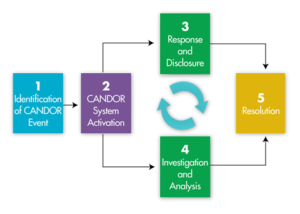
What is the Communication and Optimal Resolution Process?
Despite the best efforts of hospitals, doctors, nurses and other health care professionals, about 1 in 10 patients is harmed by the care they receive. Harms such as hospital-acquired infections or medication errors can happen during any stage of care.
The Communication and Optimal Resolution (CANDOR) process that health care institutions and practitioners can use to respond in a timely, thorough, and just way when unexpected events cause patient harm. Developed by AHRQ, the toolkit contains eight different modules, each with PowerPoint slides and facilitator notes. Select modules also contain tools, resources or videos.
The key learnings for hospitals implementing the CANDOR process in their institutions include how to:
- Engage patients and families in disclosure communication following adverse events.
- Implement a Care for the Caregiver program for providers involved in adverse events.
- Investigate and analyze an adverse event to learn from it and prevent future adverse events.
- Review and revise the organization’s current processes to align with the CANDOR process.
- Establish a resolution process for the organization.
How Does the CANDOR Process Work?
 Generally, the CANDOR process begins with identification of an event that involves harm. This activates initiation of coordinated post-event processes, as depicted (to the right) and described in the CANDOR Toolkit modules. Lean more.
Generally, the CANDOR process begins with identification of an event that involves harm. This activates initiation of coordinated post-event processes, as depicted (to the right) and described in the CANDOR Toolkit modules. Lean more.
Based on expert input and lessons learned from the Agency’s $23 million Patient Safety and Medical Liability grant initiative launched in 2009, the CANDOR toolkit was tested and applied in 14 hospitals across three U.S. health systems.
